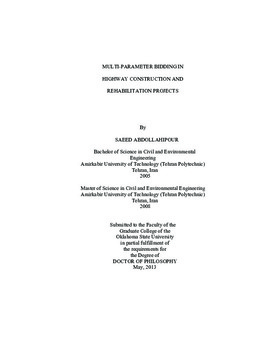| dc.contributor.advisor | Jeong, Hyung Seok (David) | |
| dc.contributor.advisor | Oberlender, Garold D. | |
| dc.contributor.author | Abdollahipour, Saeed | |
| dc.date.accessioned | 2014-09-24T14:16:23Z | |
| dc.date.available | 2014-09-24T14:16:23Z | |
| dc.date.issued | 2013-05 | |
| dc.identifier.uri | https://hdl.handle.net/11244/10951 | |
| dc.description.abstract | According to the 2013 ASCE infrastructure report card, roads have been given a grade of D. In addition, the level of federal, state, and local capital investment is insufficient and projected to result in a farther decline in conditions and performance in the long term. Poor highway conditions have caused transportation agencies to shift their focus from expanding road networks to rehabilitation of their existing infrastructures. In response to increasing road user costs caused by rehabilitation or reconstruction projects and limited resources due to insufficient capital investments, State Highway Agencies (SHAs) have started to utilize innovative contracting methods by incorporating construction time and life-cycle cost into the bidding process. In multi-parameter bidding method, a combination of price, construction time, and life-cycle cost is considered the decisive factor in awarding a contract to the successful bidder. The purpose of these bidding methods is to obtain accelerated construction at the lowest possible cost in order to minimize inconvenience to the public. However, unlike conventional bidding, SHAs are required to determine the Unit Time Value (incentive/disincentive rate) and life-cycle cost parameters before the bid process. | |
| dc.description.abstract | This study focuses on the impact of different Unit Time Values on the competitiveness of contractors in the A+B bidding process. A new criterion is introduced to assist SHAs to determine an optimal Unit Time Value to maximize the competition during the bid process. To assist SHAs in determining the value of the life-cycle cost factor, an association analysis method in data mining is applied to historical pavement treatment datasets in order to identify the sequential patterns of various maintenance and rehabilitation activities. Since the newly developed life-cycle cost analysis models are based on the actual treatment strategies, it is expected that the life-cycle cost factor determined by this model is more realistic and closer to actual costs than that of the traditional approach suggested by the Federal Highway Administration. The results of this research will facilitate collaboration among different parties in highway construction contracts. It will advance Integrated Project Delivery (IPD) methods which are a collaborative alliance between SHAs and contractors. | |
| dc.format | application/pdf | |
| dc.language | en_US | |
| dc.rights | Copyright is held by the author who has granted the Oklahoma State University Library the non-exclusive right to share this material in its institutional repository. Contact Digital Library Services at lib-dls@okstate.edu or 405-744-9161 for the permission policy on the use, reproduction or distribution of this material. | |
| dc.title | Multi-parameter bidding in highway construction and rehabilitation projects | |
| dc.contributor.committeeMember | Lewis, Phil | |
| dc.contributor.committeeMember | Liu, Tieming | |
| osu.filename | Abdollahipour_okstate_0664D_12734.pdf | |
| osu.accesstype | Open Access | |
| dc.type.genre | Dissertation | |
| dc.type.material | Text | |
| thesis.degree.discipline | Civil and Environmental Engineering | |
| thesis.degree.grantor | Oklahoma State University | |
